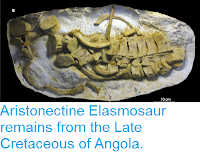The Plesiosaurs were Mesozoic marine reptiles that arose in the Late
Triassic or Early Jurassic and persisted till the Late Cretaceous. They
were related to modern lizards and snakes, but were fully aquatic, the
largest species reaching 15 m in length. All species seem to have been
strict carnivores, and at least one species gave birth to live young.
Plesiosaurs are thought to have been fully aquatic from their first
appearance; having evolved from Nothosaurs, a group of
semi-aquatic marine Reptiles. The Plesiosaurs are divided into two groups, the short-necked Pliosaurs and the long-necked Elasmosaurs.
In a paper published in the journal Alcheringa on 15 September 2017, Sven Sachs of the Naturkunde-Museum Bielefeld, and Benjamin Kear of the Museum of Evolution at Uppsala University, describe a new species of Pliosaur from the Early Jurassic Amaltheenton Formation of Bielefeld in North Rhine-Westphalia, northwest Germany.
The new species is named Arminisaurus schuberti, where 'Arminisaurus' honours Arminius, a chieftan of the Germanic Cherusci people, who defeated three Roman legions under Publius Quinctilius Varus at the Battle of the Teutoburg Forest in 9 AD, and 'schuberti' honours Siegfried Schubert, who obtained the specimen from which the species is described from the Beukenhorst-II industrial clay pit in the Bielefeld. The species is named from a fragmentary specimen comprising the posterior section of the right mandibular ramus with the surangular, angular, prearticular and articular, eight isolated teeth and other dental fragments, ten cervical vertebrae, an incomplete pectoral vertebra, at least seven dorsal vertebrae, seven caudal vertebrae and various cervical-, dorsal-, possible sacral-caudal- and gastral ribs, as well as components of what may be the clavicle and interclavicle, together with the complete right and partial left scapula, a propodial, epipodial, six mesopodials and 19 phalanges abd other indeterminate bone fragments.
Arminisaurus schuberti, dorsal vertebra in (A) anterior and (B) lateral view. Dorsal neural spine in anterior view (C). Caudal vertebra in (D) articular, (E) lateral, (F) dorsal and (G) ventral views. Dorsal rib (H), caudal rib or hemapophysis (I), gastral rib (J) and ?sacral rib (K). Scale bars are 30 mm. Abbreviations: con, concavity; hf, hemapophyseal facet; nc, neural canal; ns, neural spine; rf, rib facet; tp, transverse process. Sachs & Kear (2017).
See also...
Follow Sciency Thoughts on Facebook.







